Preface
I'm
a sucker for keyboard shortcuts. Give me a way to get my hand
off the mouse and I'm all for it. Nothing against the mouse,
mind you it's incredibly useful for certain tasks, and I love
right-clicking. However, I find that using the keyboard whenever
possible allows me to work faster and my wrist doesn't get tired
as quickly.
Apple
has done a good job with keyboard shortcuts in Motion. Many of
them are consistent with the other Pro Apps, like Final Cut Pro.
Here, we'll focus on the shortcuts that enable you to quickly
navigate to different parts of the interface.
For
this short article I'm assuming you are familiar with the basic
Motion interface and know where to click in order to do things
like add objects to your project, apply filters and behaviors,
tweak parameters, reorder layers, and adjust timing. So let's
speed up the process of getting where you want to go, and you
can focus on being creative!
The
Motion Landscape
The
Motion interface includes 3 work areas called "panes"
which you use while building and adjusting your project: the
Utility Pane, the Project Pane, and the Timing Pane.
When
you first launch Motion, by default the Project and Timing panes
are closed. You can open them by either dragging on the pane's
divider bar or by clicking on the appropriate icon in the Tool
bar.
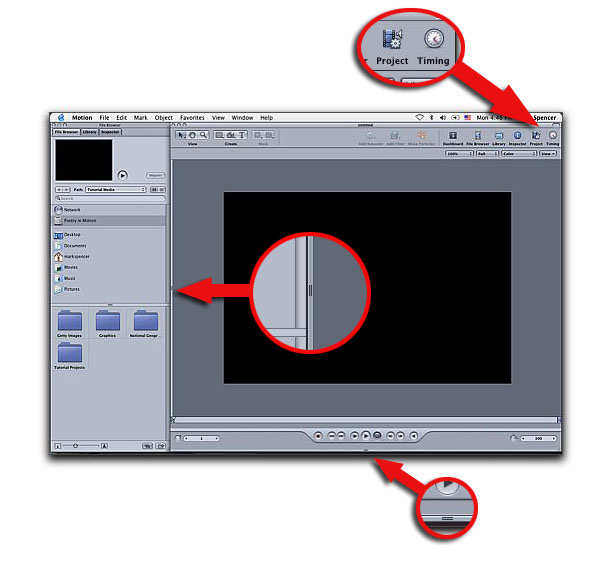
But
why drag or click with the mouse when you can use a keyboard
shortcut? The function key F5 will open and close the Project
pane; F6 does the same for the timing pane.
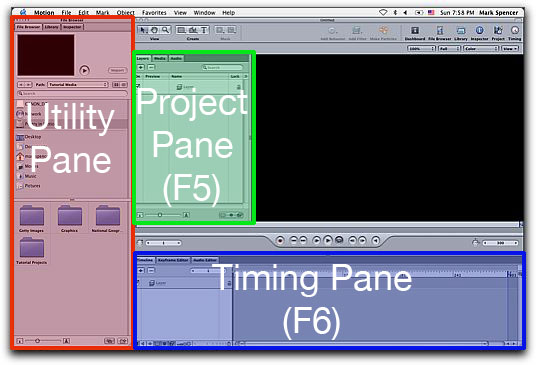 |
F5
opens the Project Pane
F6
opens the Timing Pane
The
Utility Pane is already
open by default
|
Put
it on My Tab
Each
pane in Motion has three tabs. While F5 and F6 are nice ways
to quickly open the Project pane and Timing pane, respectively,
the tab that is active when you do so will be either the first
tab in the Pane or the tab that you most recently had active.
That's often fine, but if you know in advance the tab you want,
you can navigate directly to it in one keystroke which will 1)
open the pane if it's closed and 2) bring the desired tab to
the front. What's really cool is that Apple has done a great
job at making the keyboard shorcuts to each of these nine tabs
very logical: using the Command key in combination with numbers
1 through 9 will move you through each of the tabs, left to right,
top to bottom:
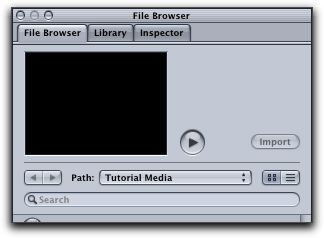 |
Command-1:
File Browser
Command-2:
Library
Command-3:
Inspector
|
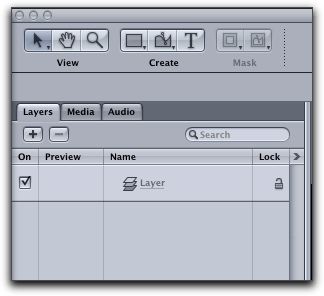 |
Command-4:
Layers
Command-5:
Media
Command-6:
Audio
|
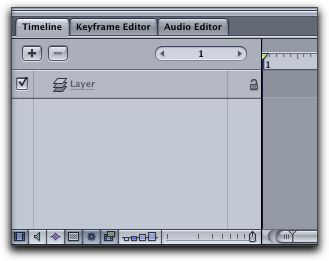 |
Command-7:
Timeline
Command-8:
Keyframe Editor
Command-9:
Audio Editor
|
If
you enter a keyboard shortcut for a tab that is already active,
the entire pane will close, including the utility pane. Hit the
key combination again to bring it back.
Tabs
Within Tabs: Navigating the Inspector
The
Inspector tab of the Utility pane is different in that it contains
four of its own tabs: Properties, Behaviors, Filters,
and a fourth context-sensitive tab which changes its name
depending on what type of object you have selected. Now, if you
want to get to the Behaviors tab for example, do you need to
hit Command-3 for the Inspector and then click on the Behaviors
tab? Of course not! More function keys to the rescue:
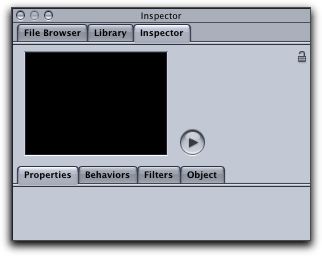 |
F1:
Properties
F2:
Behaviors
F3:
Filters
F4:
Object (context-sensitive)
|
Easy,
no? F1 through F4 handle the Inspector tabs; F5 opens and closes
the Project Pane; F6 opens and closes the Timing Pane. Hmm...what
about F7? Ah, the Dashboard!
 |
F7:
Reveal/Hide the Dashboard
|
Strategies
Try
out these keyboard combinations and see what works for you. I
find the keystrokes I use the most often in a typical workflow
are:
- Command-1
for the File Browser in order to find and select objects to include
in the project
- F1
for the Properties tab to fine-tune transformations after click-dragging
in the Canvas
- Command-2
for the Library to add filters and behaviors
- F4
for adjusting the object-specfic parameters that aren't in the
Dashboard
- F5
to open the Project Pane and work in the Layers tab (Command-4
will do the same thing)
- F6
to open the Timing tab and adjust the length of time behaviors
and filters impact objects (Command-7 will work as well)
And
if you forget the keyboard shorcuts, they are all conveniently
located under the Window menu:

Summary
Keyboard
shortcuts for navigating to different tabs in Motion are intuitive
and easy. Use F5 and F6 to quickly open the Project Pane (F5)
and Timing Pane (F6), make adjustments, and jump back to a larger
canvas. Or, just use the Command key with numbers 1 through 9
to directly open the 9 primary tabs. To get directly to the sub-tabs
in the Inspector, F1 through F4 are your good buddies.
Learn
them and use them your wrist will thank you!
Mark Spencer
Copyright © 2004
Day Street Productions, Inc.
Mark
Spencer
is a freelance editor, teacher and writer. Apple-certified to
teach Final Cut Pro, Final Cut Pro Advanced, and Motion, he is
also currently writing the Motion Visual Quickstart Guide for
Peachpit Press.
All screen captures, images, and textual references are the property
and trademark of their creators/owners/publishers.
This article first
appeared on www.kenstone.net and is reprinted here
with permission.
All screen captures and
textual references are the property and trademark of their creators/owners/publishers.